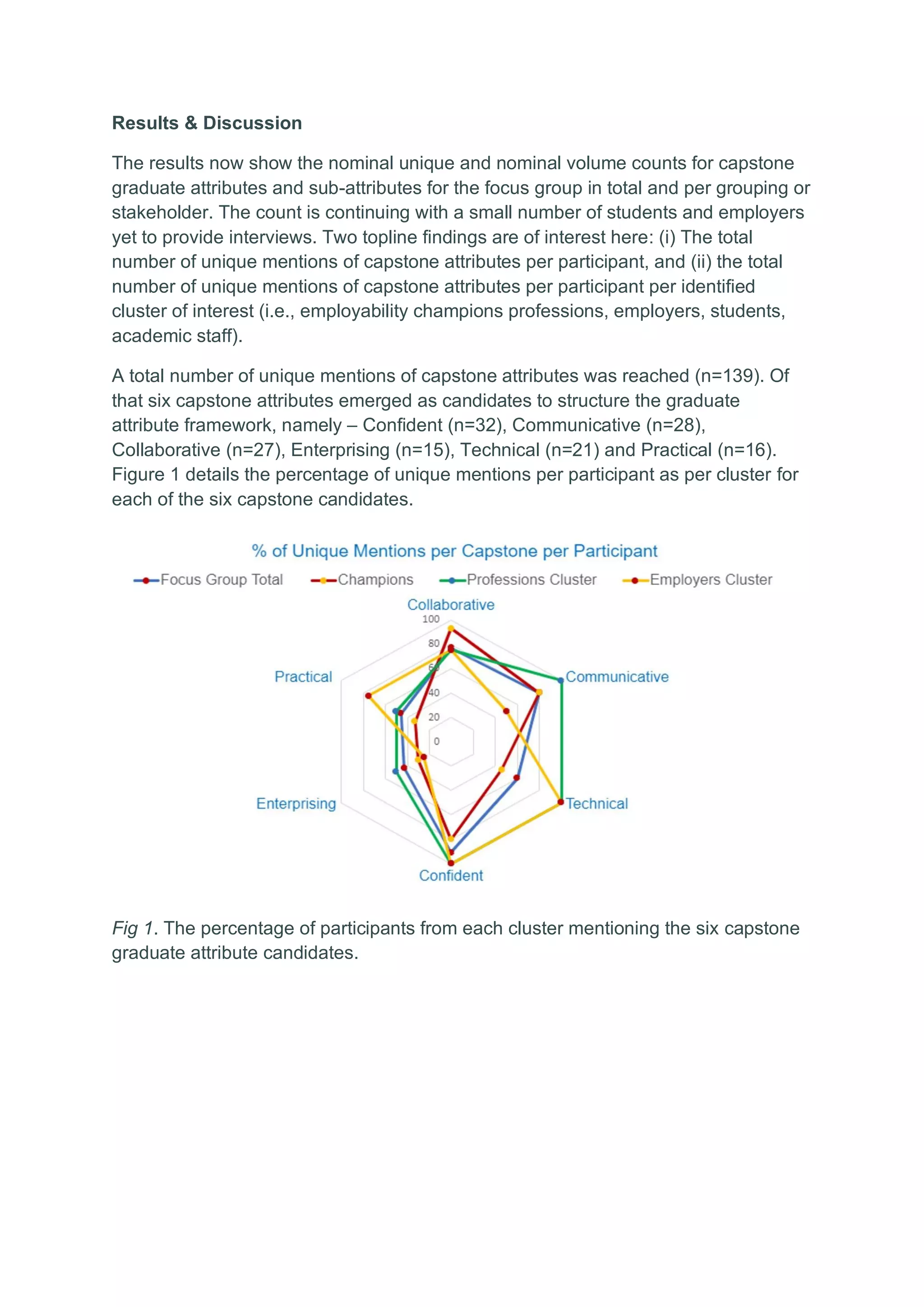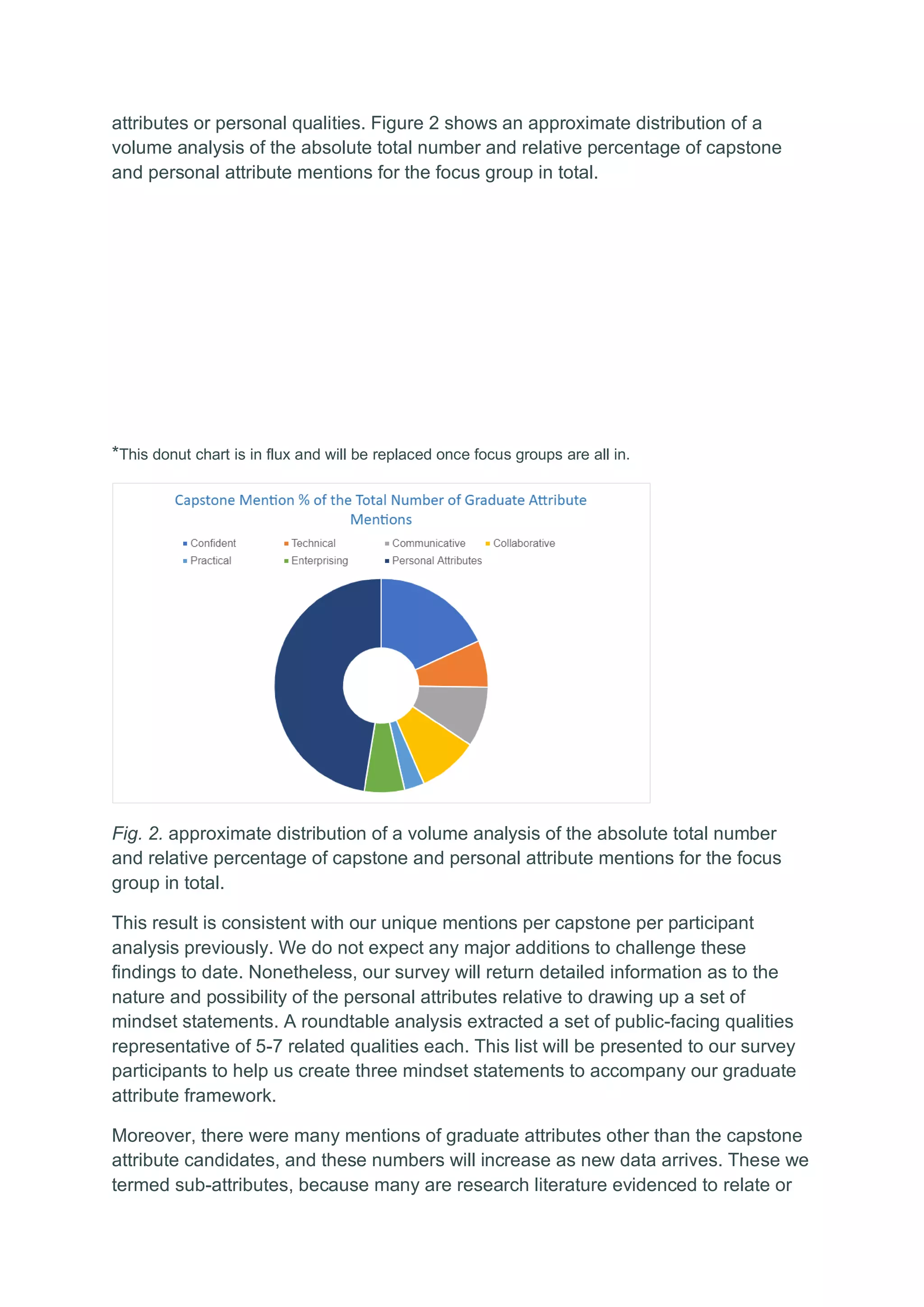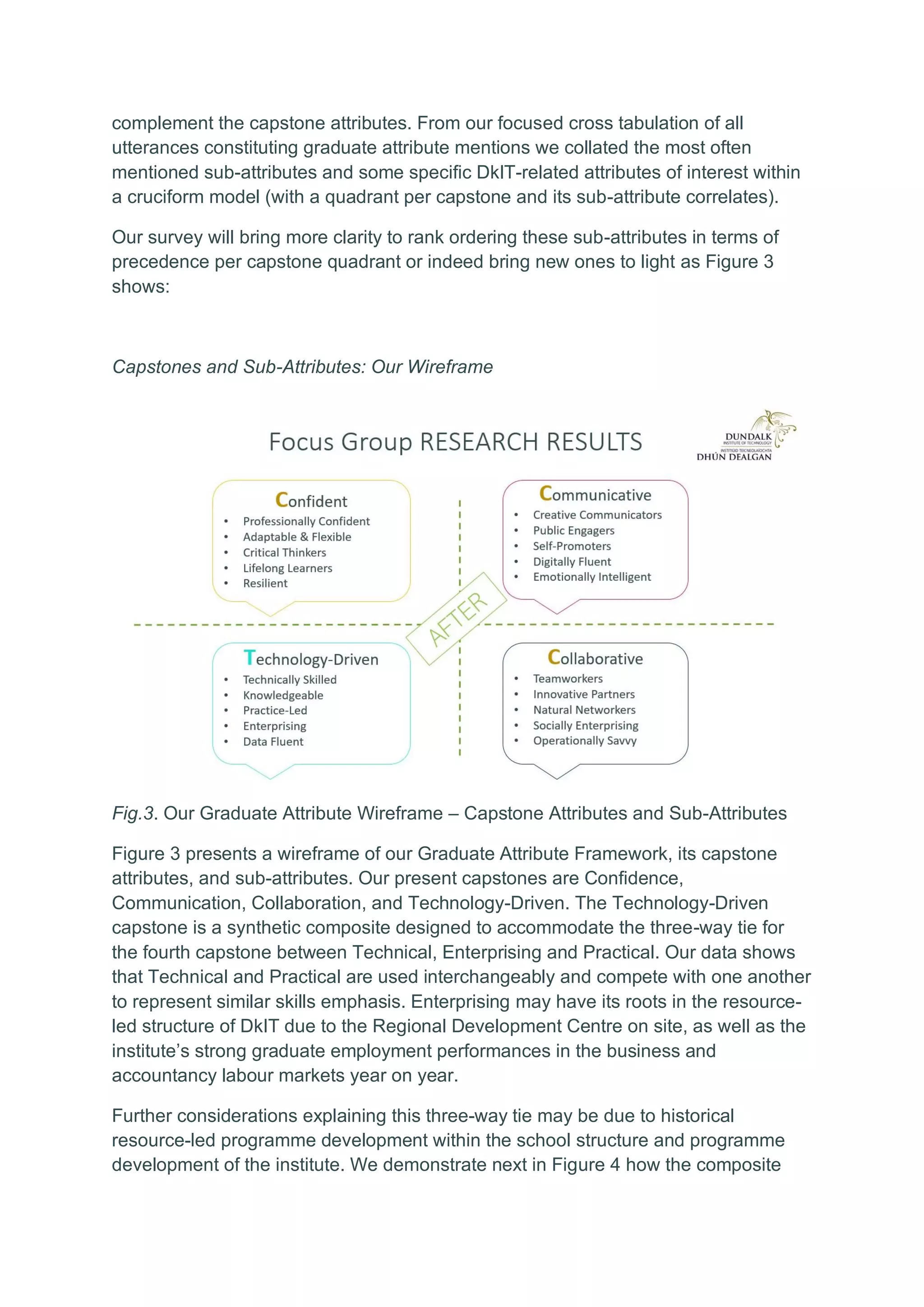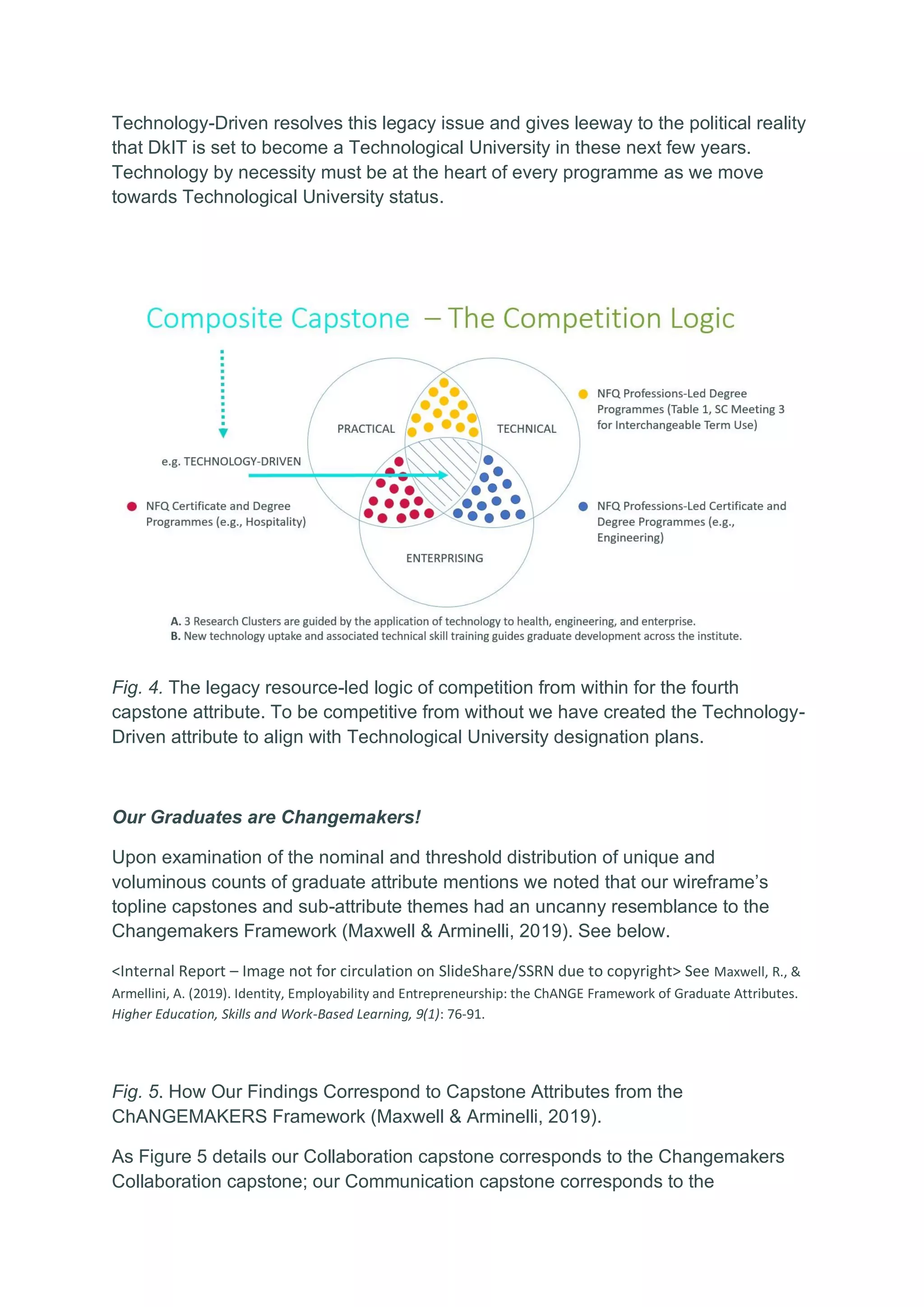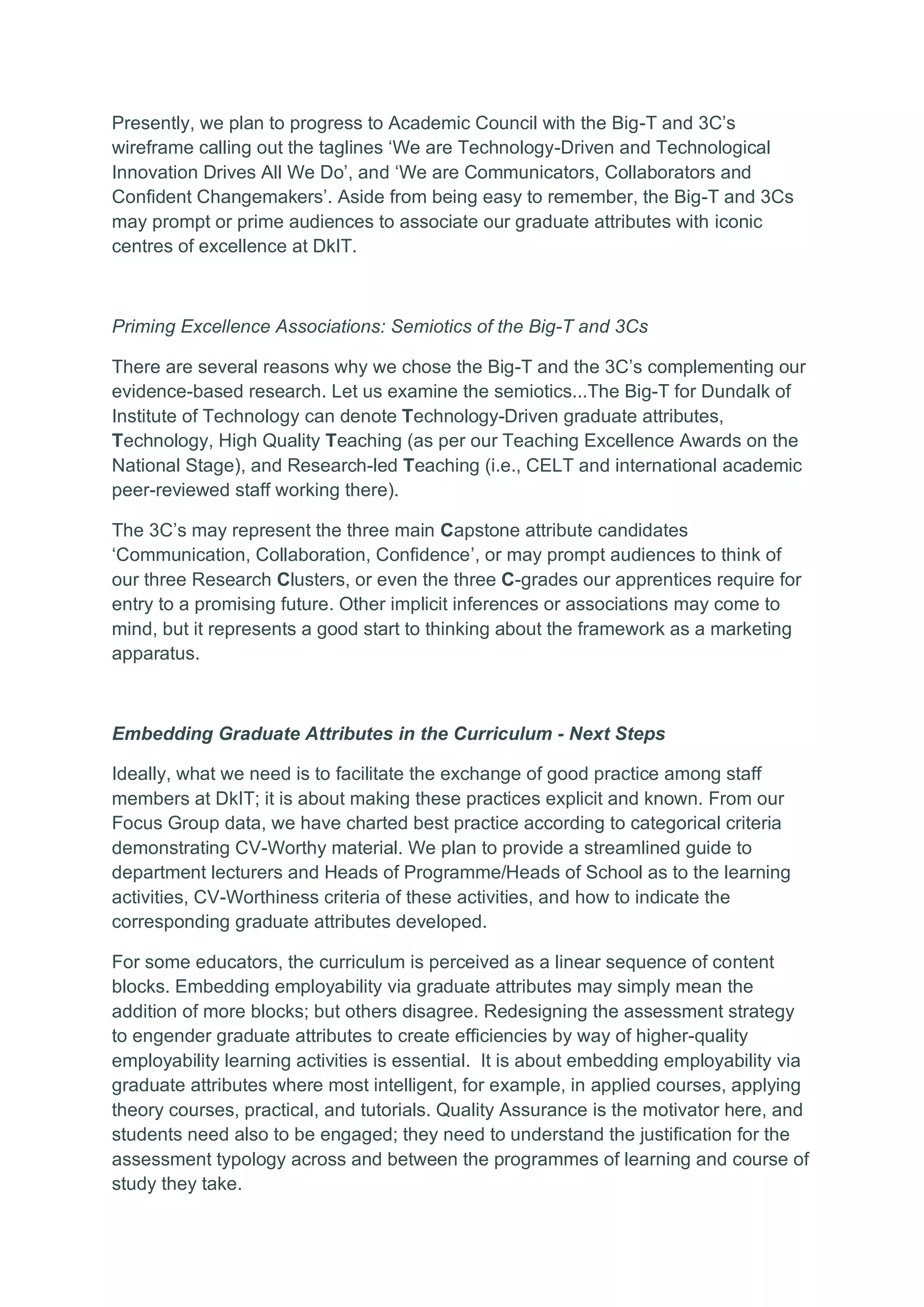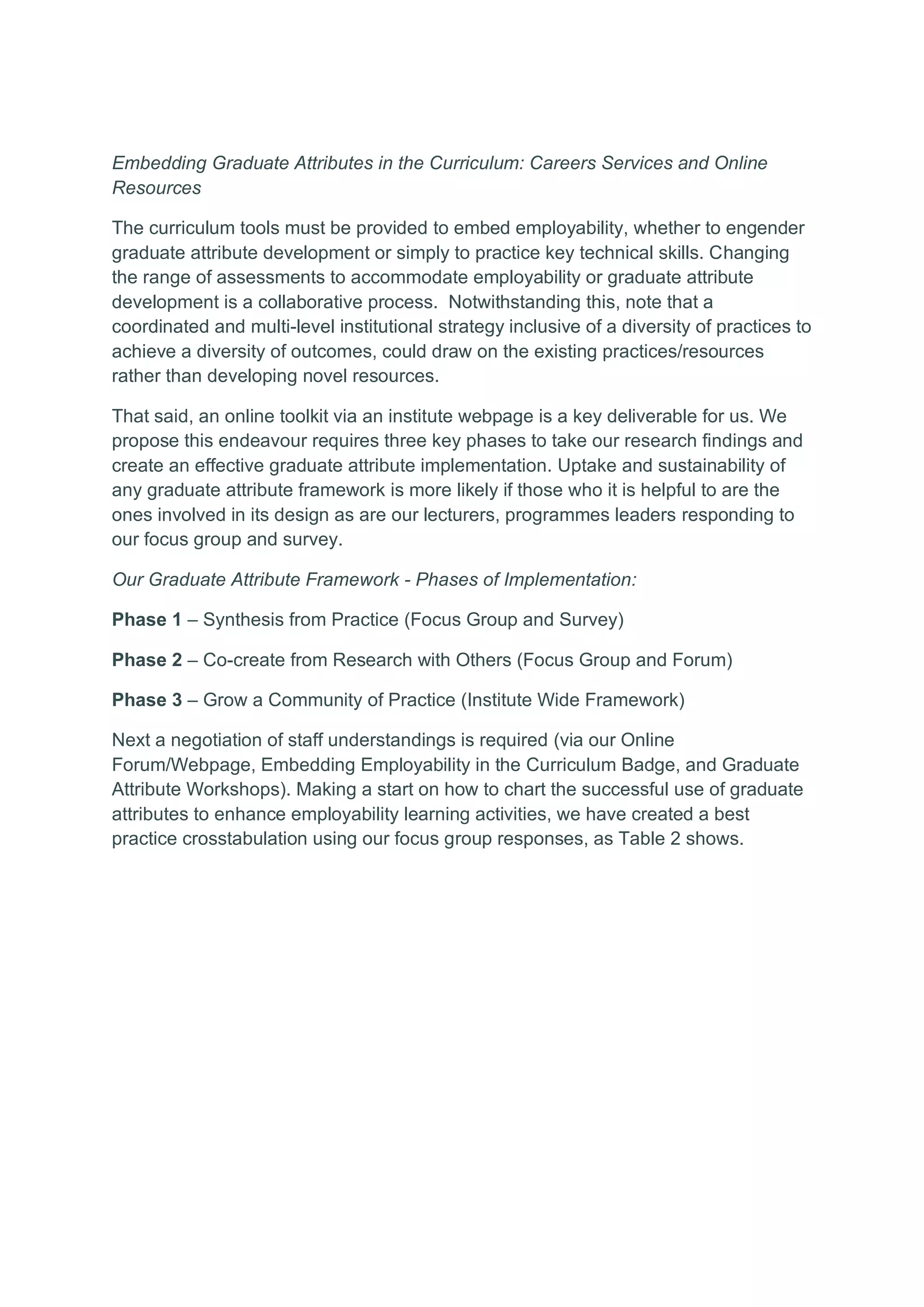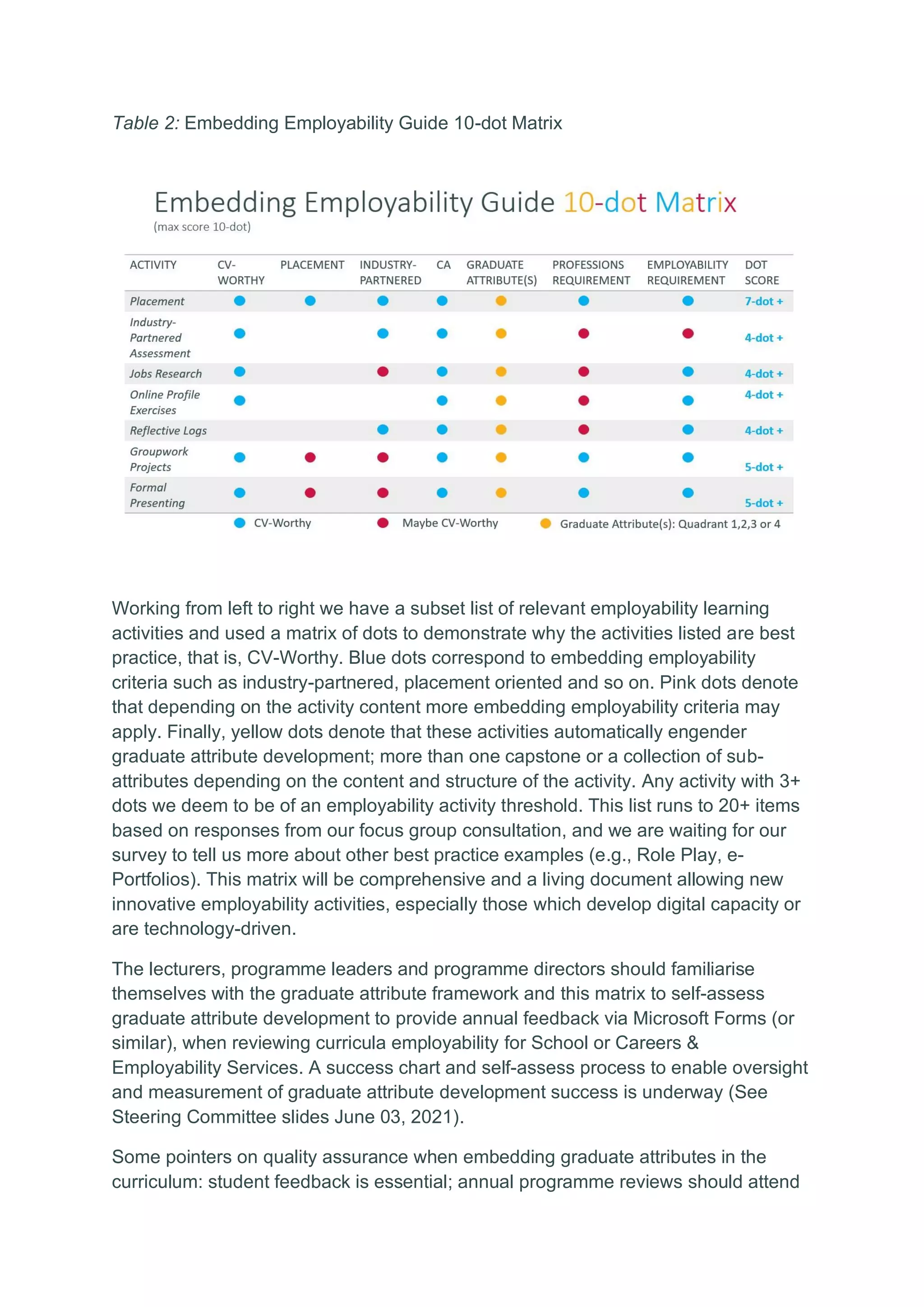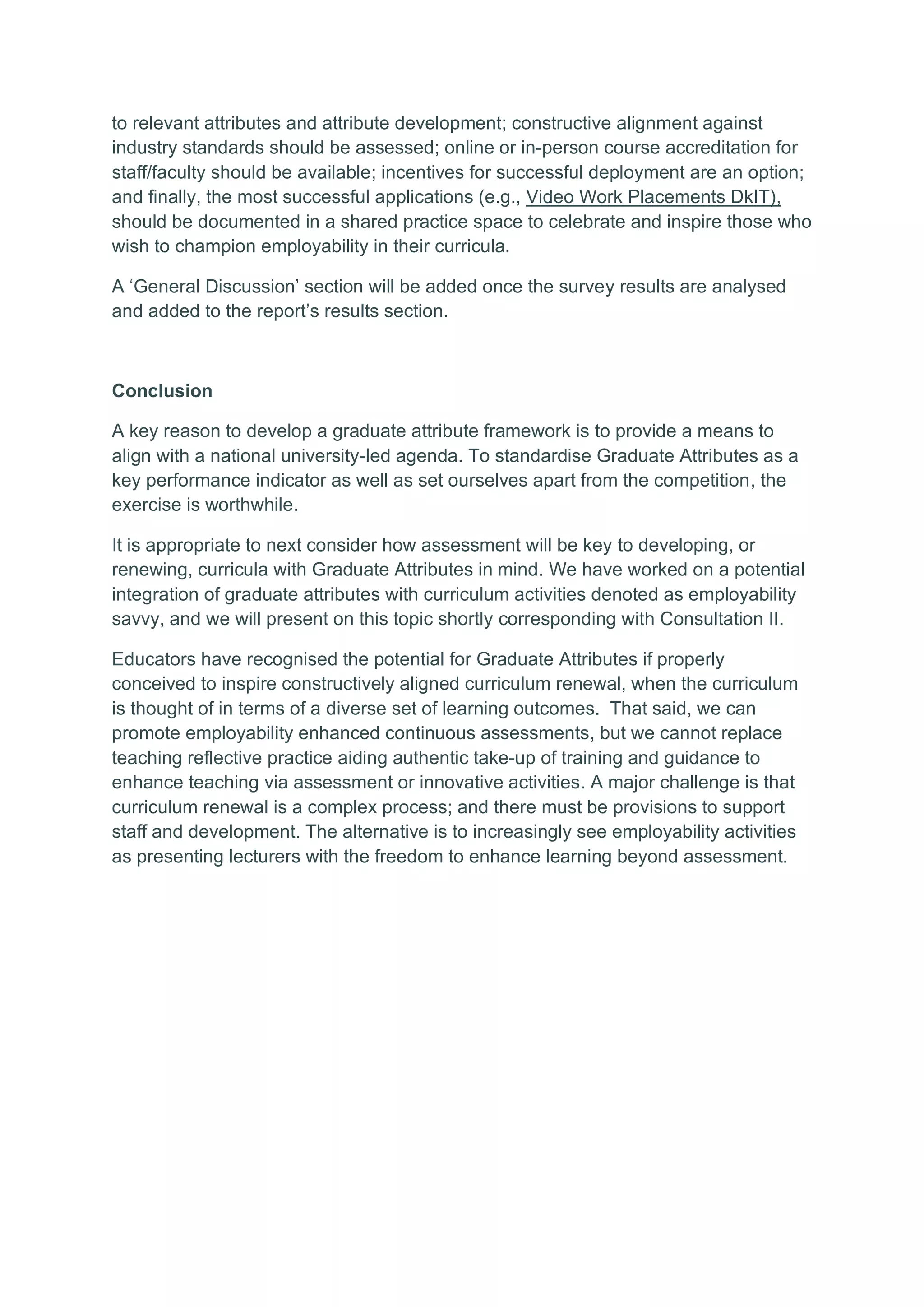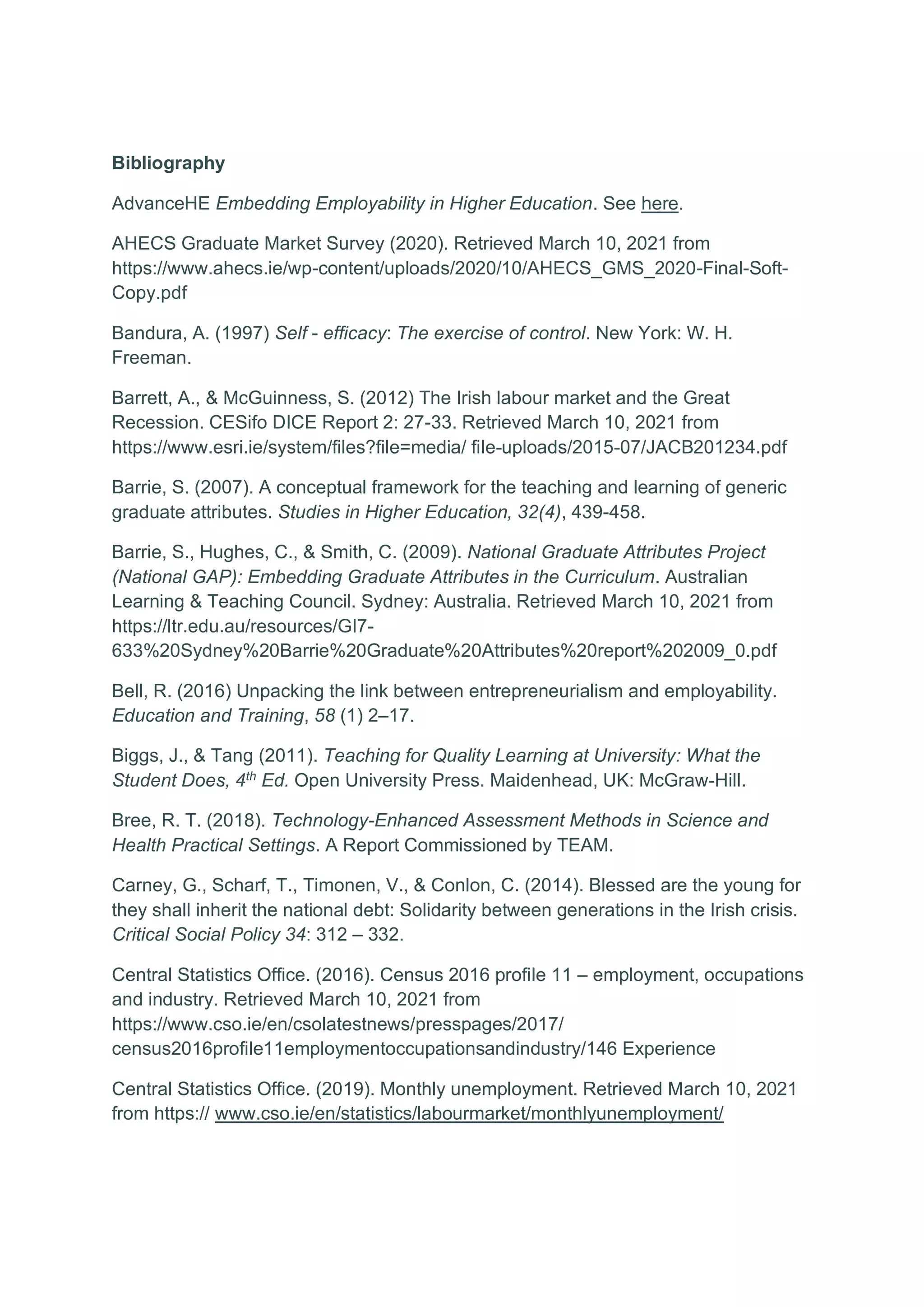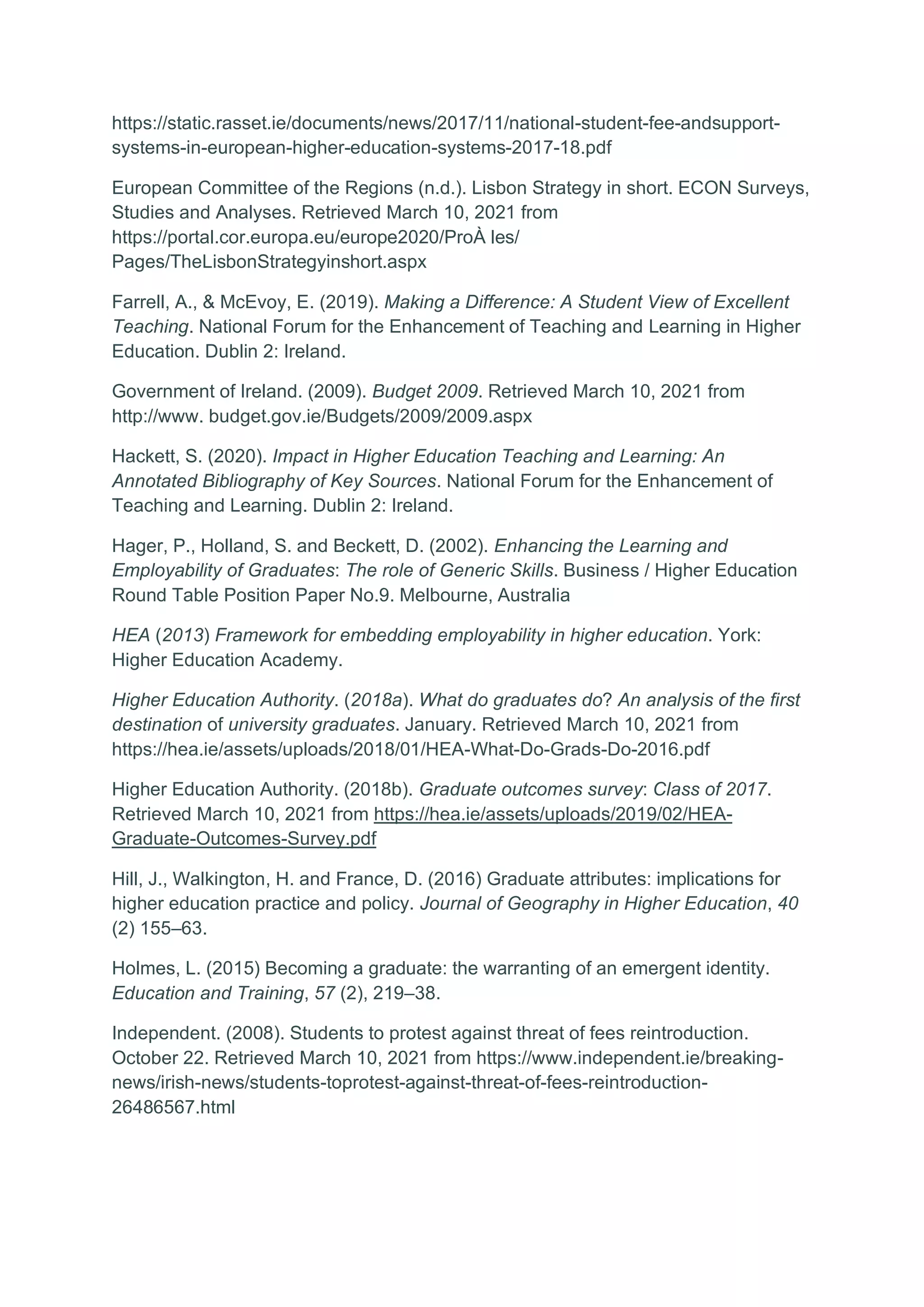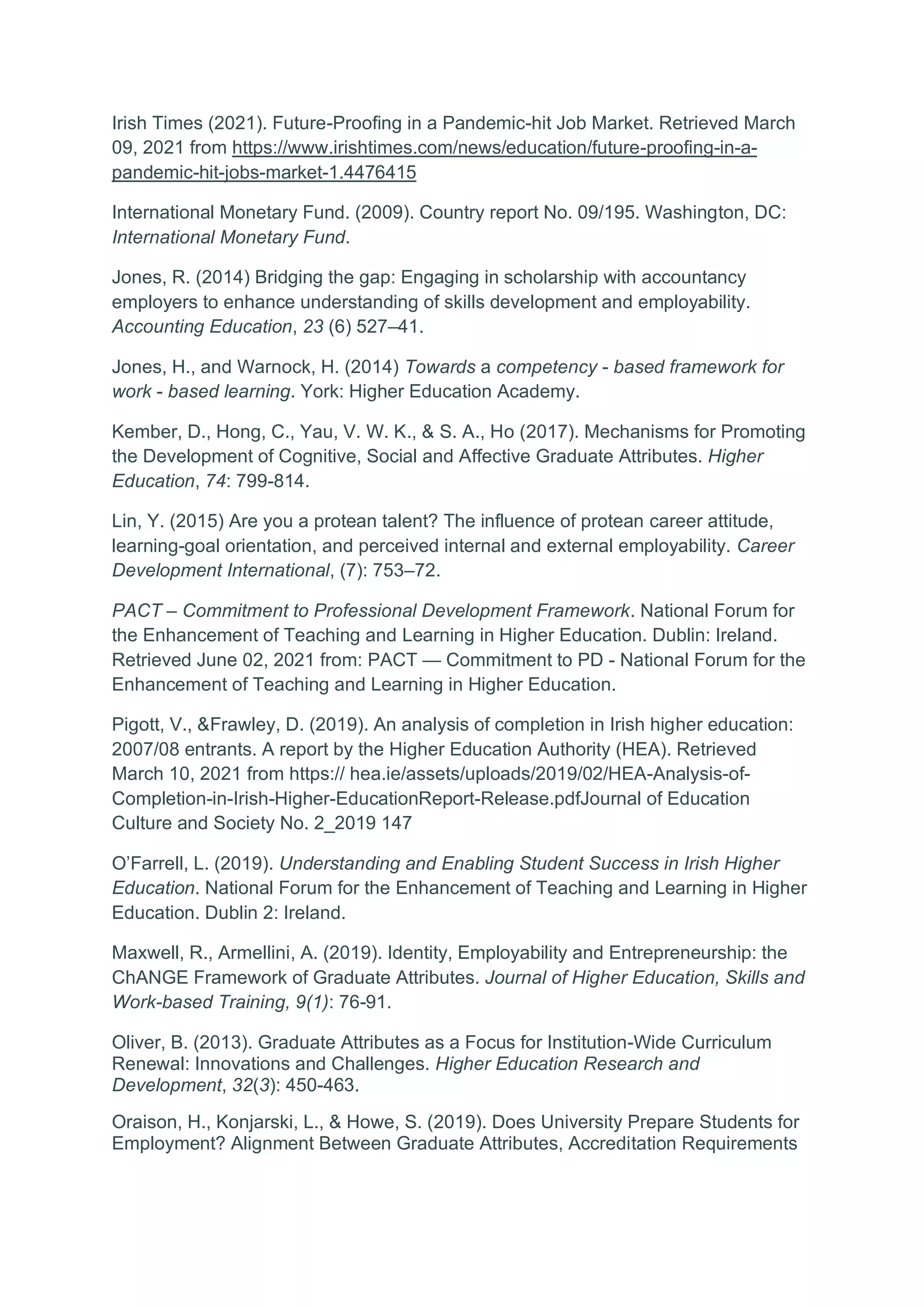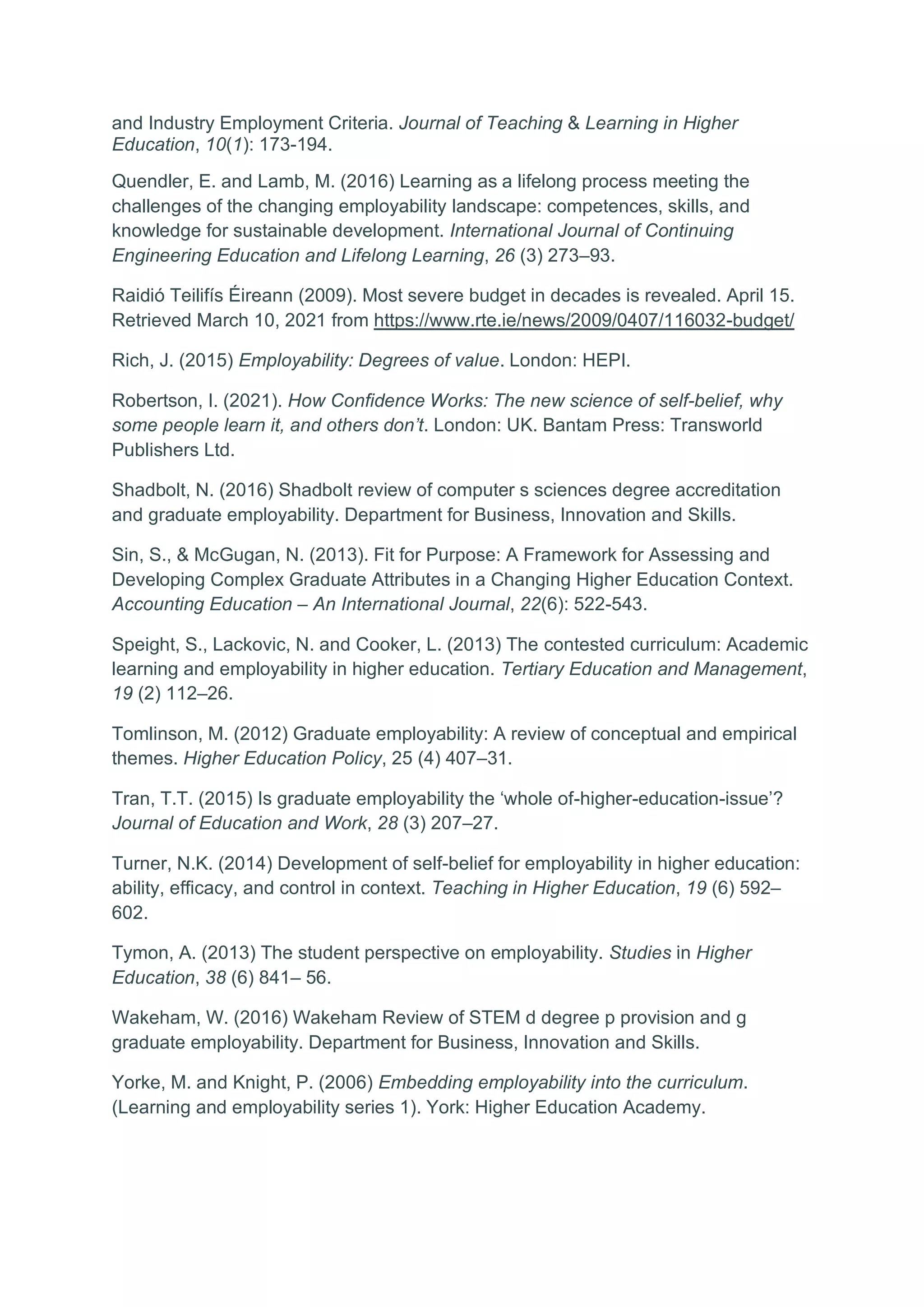The document outlines the development of a graduate attribute framework at Dundalk Institute of Technology to enhance employability and student success through the cultivation of essential skills and values. It discusses the broader economic and policy context impacting higher education in Ireland, particularly following the 2007 financial crisis, and emphasizes the need for an inclusive curriculum that incorporates these graduate attributes. The report also highlights various frameworks and theories related to graduate attributes and the necessity for institutions to adapt to evolving labor market demands, ensuring that graduates are well-prepared for future employment.
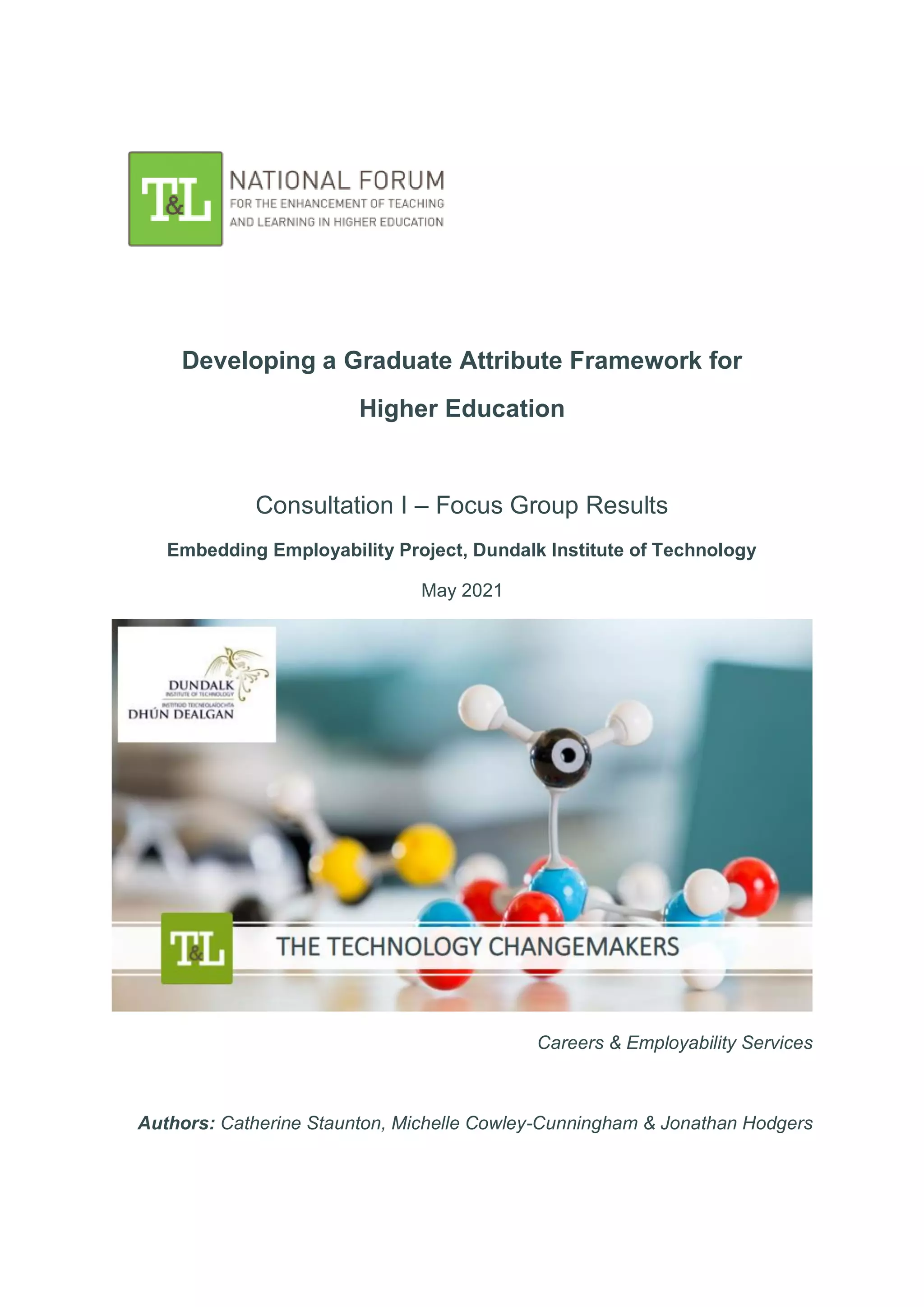
![Introduction
Graduate Attributes are the core abilities and values a higher education institute
community agrees all its graduates should develop. They are the abilities employers
deem necessary for today’s knowledge workers and graduate success (HEA UK,
2013). The National Framework for the Enhancement of Teaching and Learning in
Higher Education identifies ‘Student Success’ as:
‘Student success optimises the learning and development opportunities for each
student to recognise and fulfil their potential to contribute to, and flourish in, society.
To be achieved, this requires a culture in Irish higher education that values
inclusivity, equity and meaningful engagement between students, staff,
their institutions, and the wider community…’ (Farrell & McEvoy, 2019)
The Graduate Attribute agenda is key to fulfilling this promise to its students by
Dundalk Institute of Technology, and this report outlines the results of our research
with the goal of establishing our own graduate attribute framework. First, we review
the development of the policy context driving graduate attribute development
nationwide, and then turn to a discussion of relevant graduate attribute theories to
ground our research. Finally, we present the main results of our first piece of
research on graduate attributes, namely our Focus Group Consultation, and outline
the implications.
HE Economic & Policy Context: The Drivers of Graduate Attribute
Development
The global financial crisis of 2007, and the subsequent Great Recession affected
Ireland’s graduates’ chances of employment success. With a contraction of most
economic sectors, employment problems for graduates were bound to emerge. A
cognizance of how graduates would need to be at their most flexible, adaptable, and
resilient was palpable, but what were higher education institutes to do and where
would they find the financial resources to support the graduate labour market?
The Irish education sector was impacted by a major cutback of €81 million, primarily
in higher education and capital expenditure (Raidió Teilifís Éireann [RTÉ], 2009).
The emergency intervention commenced a policy of deflation and austerity to offset
the effects on the exchequer and to protect Ireland’s international competitiveness
(see Emon & Timonen for full discussion, 2019). To put this in perspective, the Irish
government was forced to spend €73 billion to bail out the banking sector, enabling](https://image.slidesharecdn.com/ssrn-id38783121-210702152158/75/Developing-a-Graduate-Attribute-Framework-in-Higher-Education-Focus-Group-Report-2-2048.jpg)
![difficult consequences for public debt, domestic investment, and unemployment
(Government of Ireland [GOI], 2009; International Monetary Fund [IMF], 2009).
A hiring freeze on academic staff, increased taxes and a reduction in the salaries
and pensions of public sector employees amounting to €11.5 billion (GoI, 2009), and
the reinstatement of student fees not experienced since 1995, would all play a role.
From 2017-2018, approximately €3000 in annual fees are paid by Irish full -time
undergraduate students. Ireland is the second highest fee charging country in the EU
for third-level education, behind the UK (European Commission, Education,
Audiovisual & Culture Executive Agency & Eurydice, 2017). Nonetheless, record
enrolments in Irish colleges continue. As of 2016-2017, a total of 43,569 students
enrolled (Pigott & Frawley, 2019; cited in Emon & Timonen, 2019).
Many may have embraced higher education to avoid becoming an unemployment
statistic, seeing unemployment increase from 4% to 4.5% in the seven years
preceding recession (2000-2007) to 15% in 2012 (Duffy, FitzGerald, Timoney &
Byrne, 2014; Barrett & McGuinness, 2012). The youth unemployment rate (15-24
years) peaked to 16% in August 2016 (Central Statistics Office [CSO], 2016), but
pre-recession levels are returning 10.31% (CSO, 2019). These numbers may all the
same not mean that our youth are seeking education to avoid unemployment; they
do not tell us why individuals are unemployed, or if employed, or whether in the sorts
of jobs commensurate with their educational level, qualification subject, or aspiration.
Add to that, the emigration of young, qualified individuals, and is difficult to speculate
as to the unemployment avoidance motives of increasing enrolment numbers
(Carney, Scharf, Timonen, & Conlon, 2014).
Policy Context and the Development of Graduate Attributes: Unleashing the Power
of Human Potential
Hope was on the horizon albeit with the goal of drawing on human potential, the
stamina and the resources of future students and their lecturers. Enter the ‘Irish
National Skills Strategy 2025’, which prioritises the development of workplace skills
in all academic courses through work placement and/or promotion of lifelong
learning.
The reasons for this stance are logical as follows. First, since the 1960s higher
education in Ireland, as in the EU, has favoured the ‘human capital’ perspective,
emphasising education as key to economic growth and productivity. Second,
globalization accelerations towards the ‘smart’ or knowledge economy has facilitated
this perspective from the 1990s and beyond (Dukelow & Considine, 2017). Third, the
goals of the Lisbon Strategy (2000) and its successor, Europe 2020, have all
prioritized investing in people, entrepreneurship, and adaptive knowledge
competencies (see Emon & Timonen for full discussion, 2019).](https://image.slidesharecdn.com/ssrn-id38783121-210702152158/75/Developing-a-Graduate-Attribute-Framework-in-Higher-Education-Focus-Group-Report-3-2048.jpg)
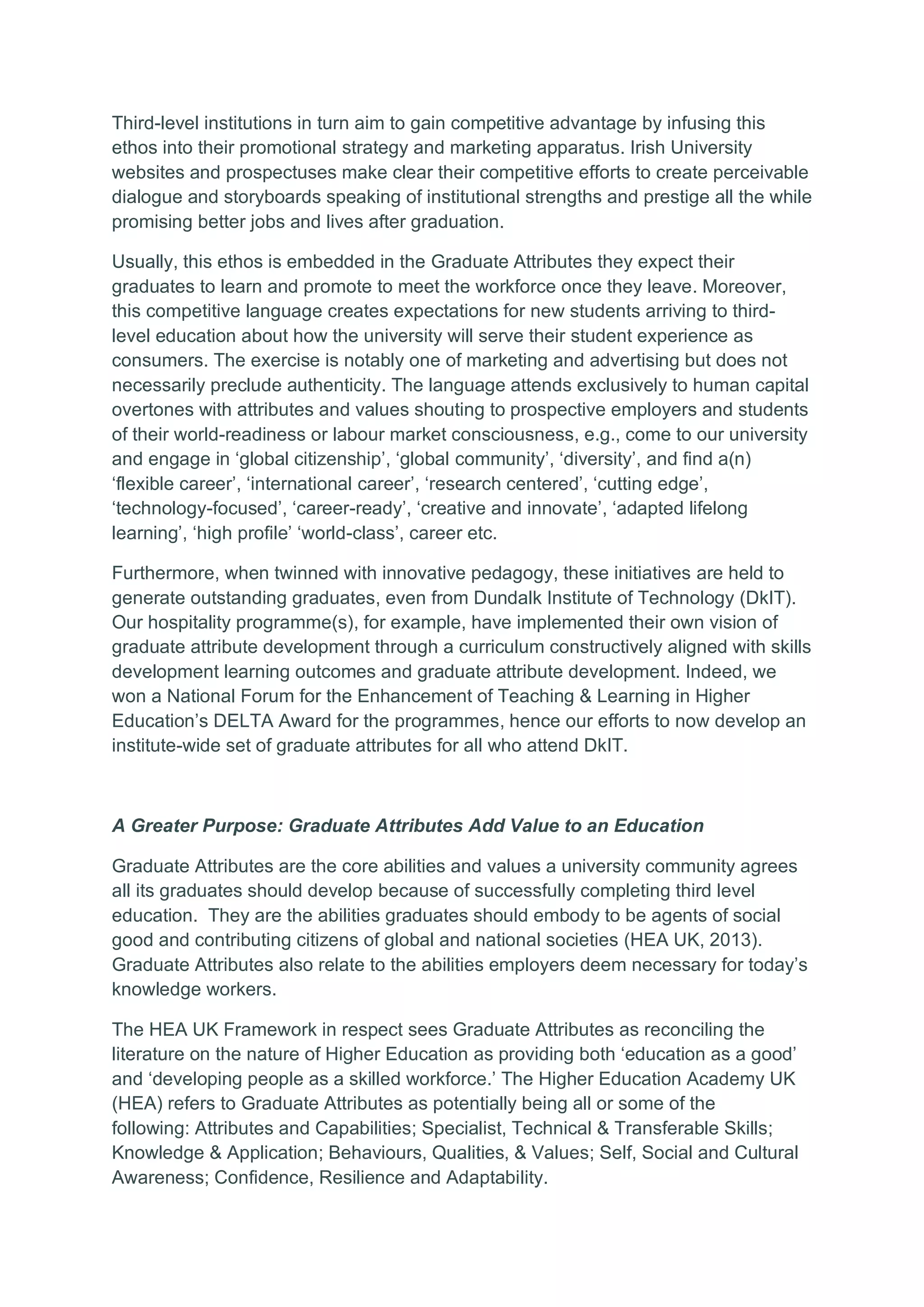
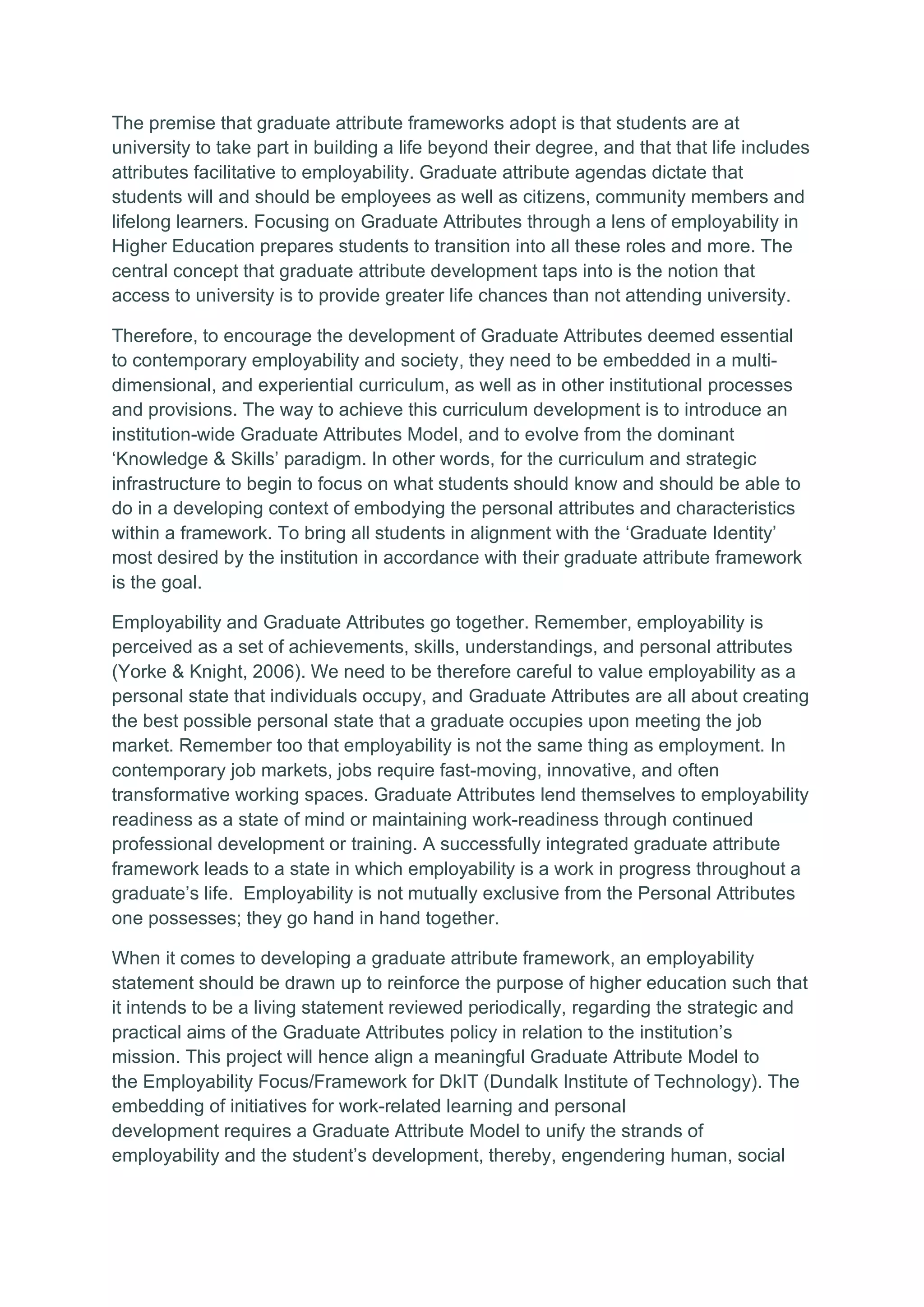
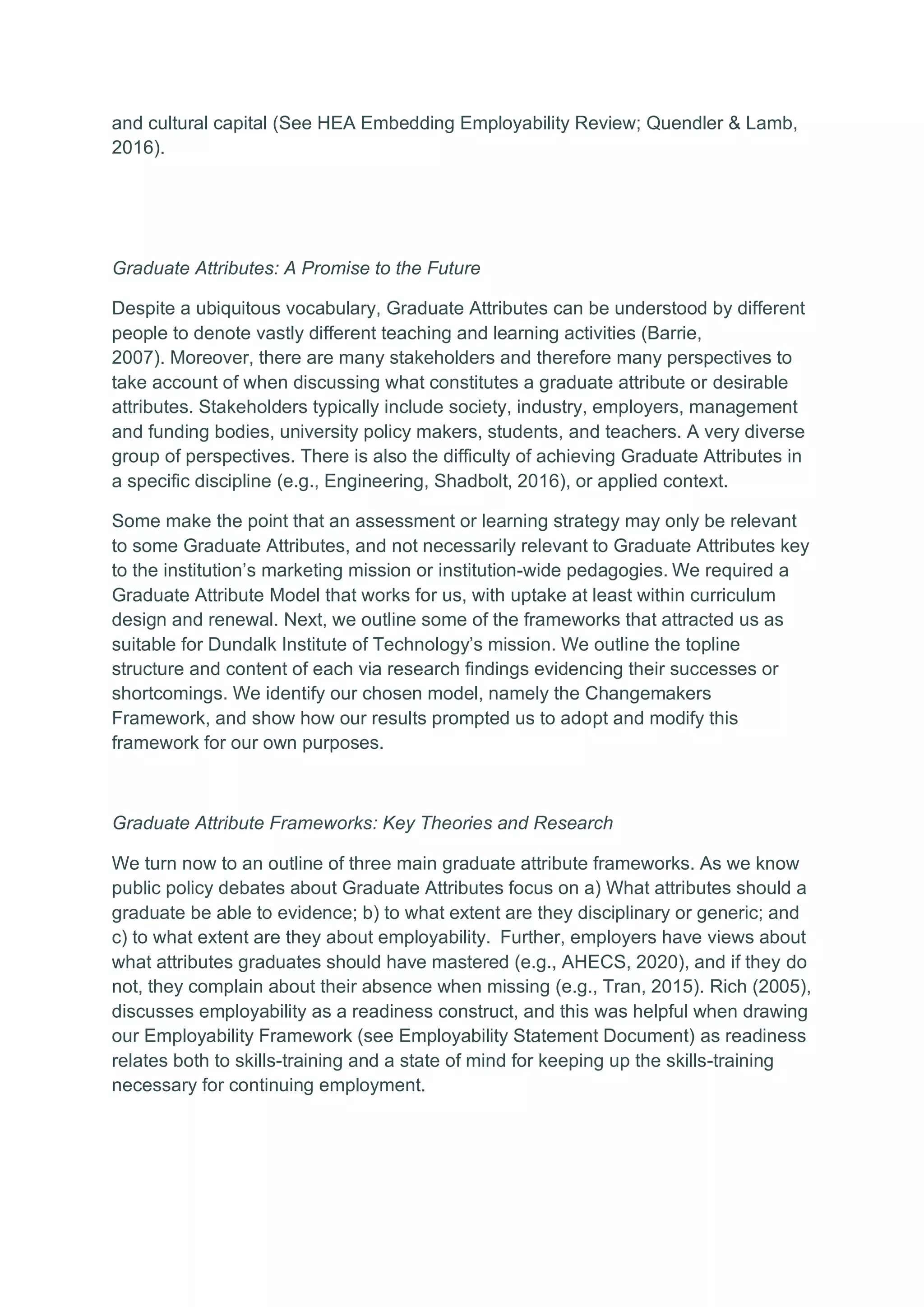
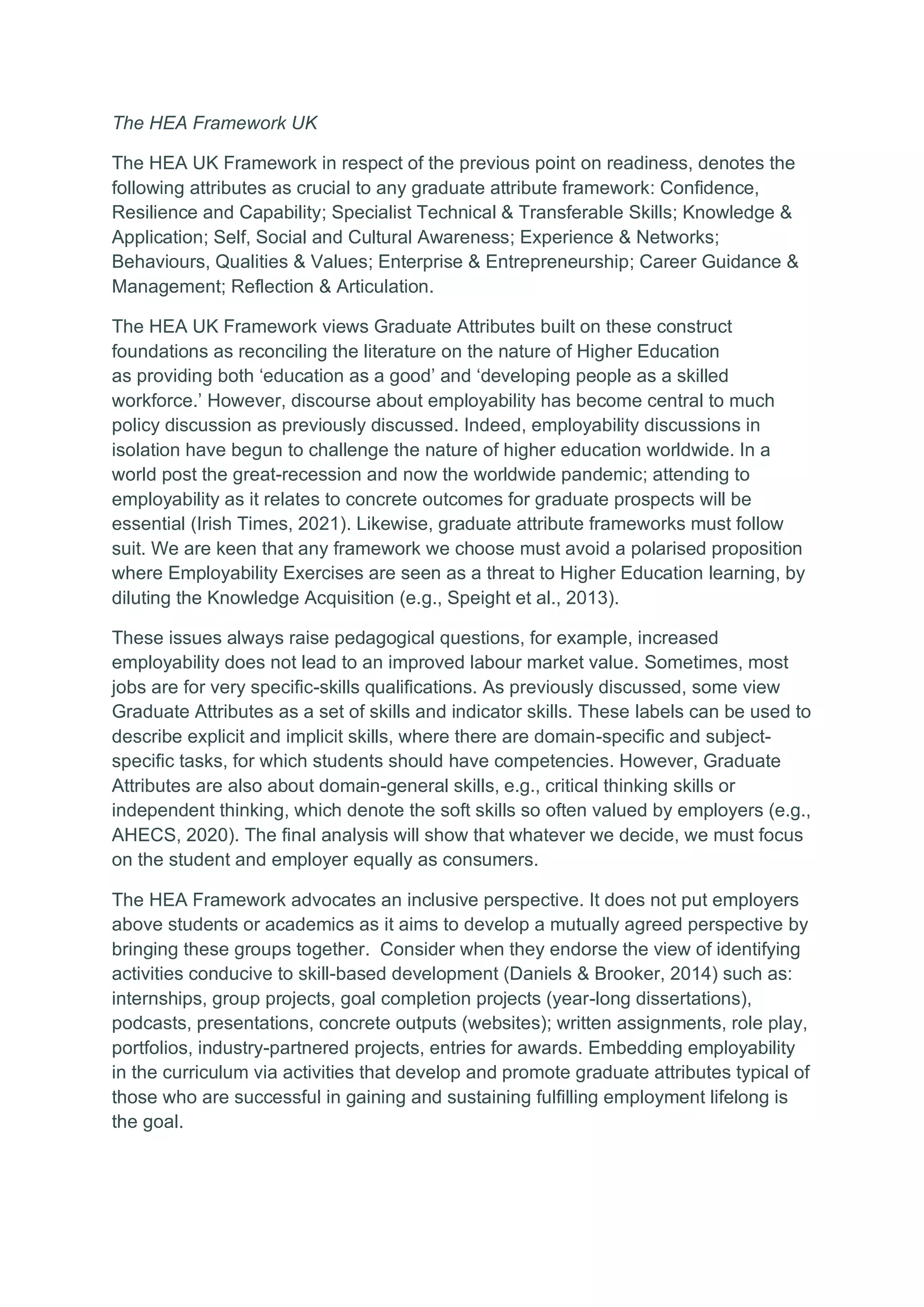
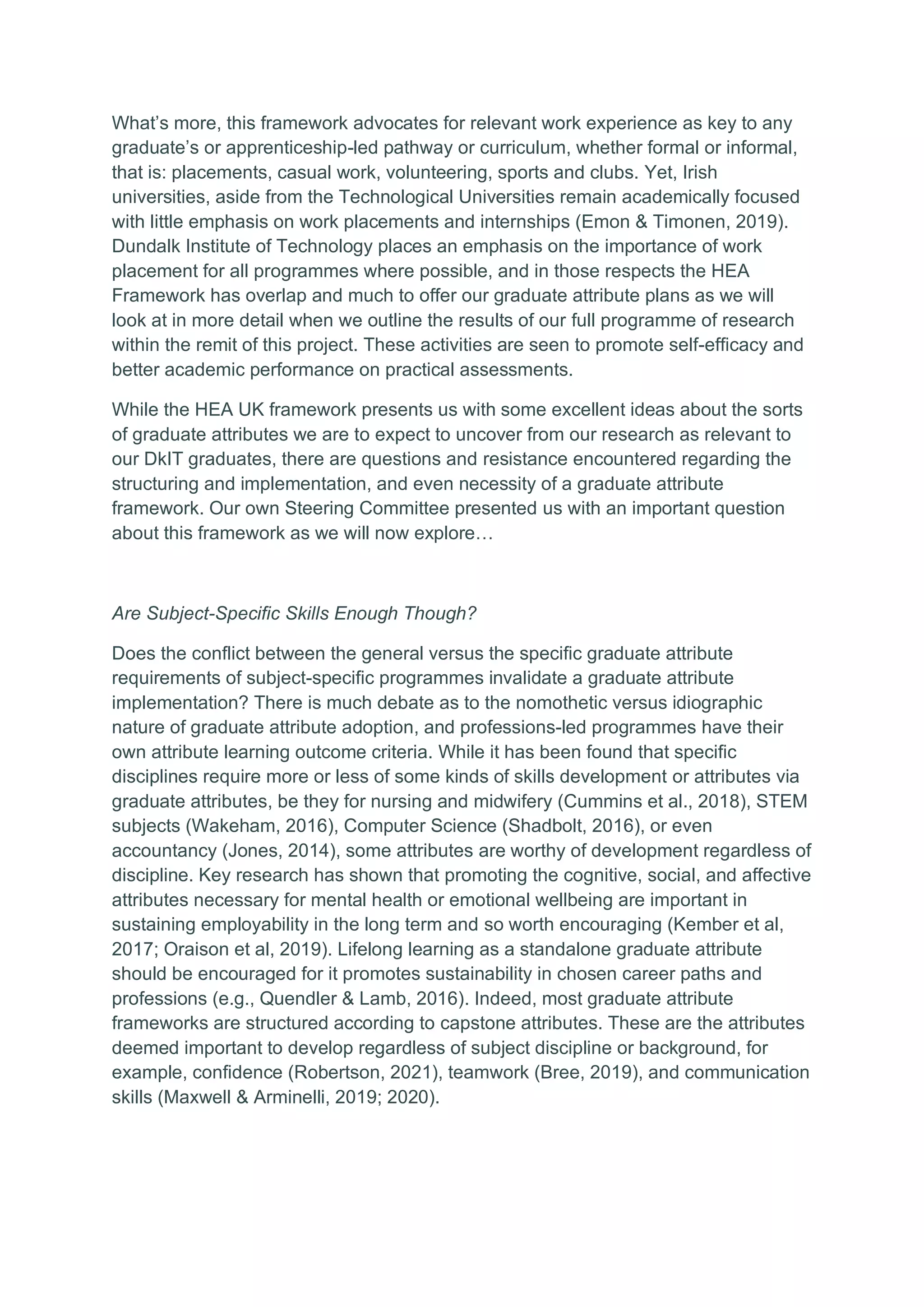
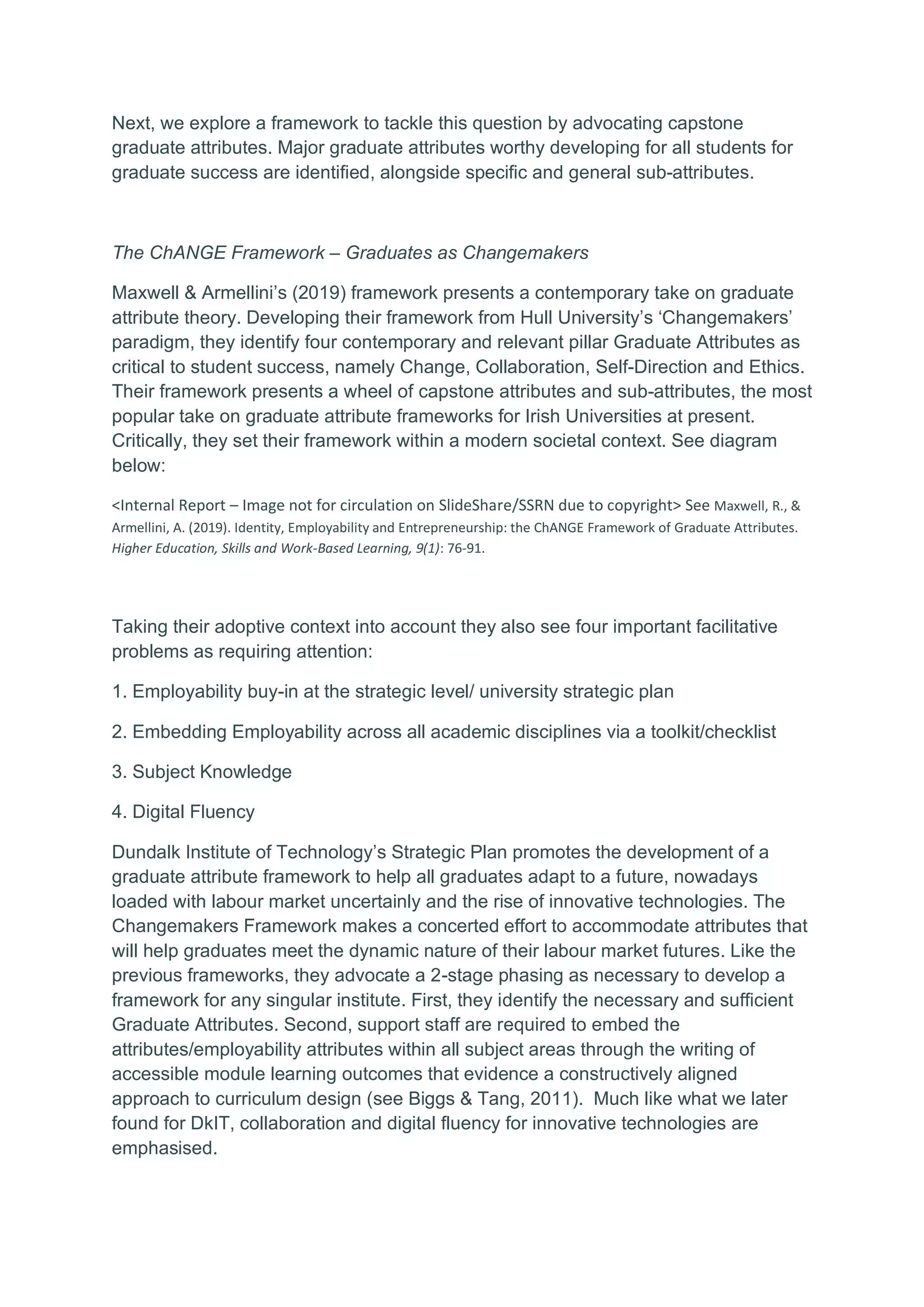
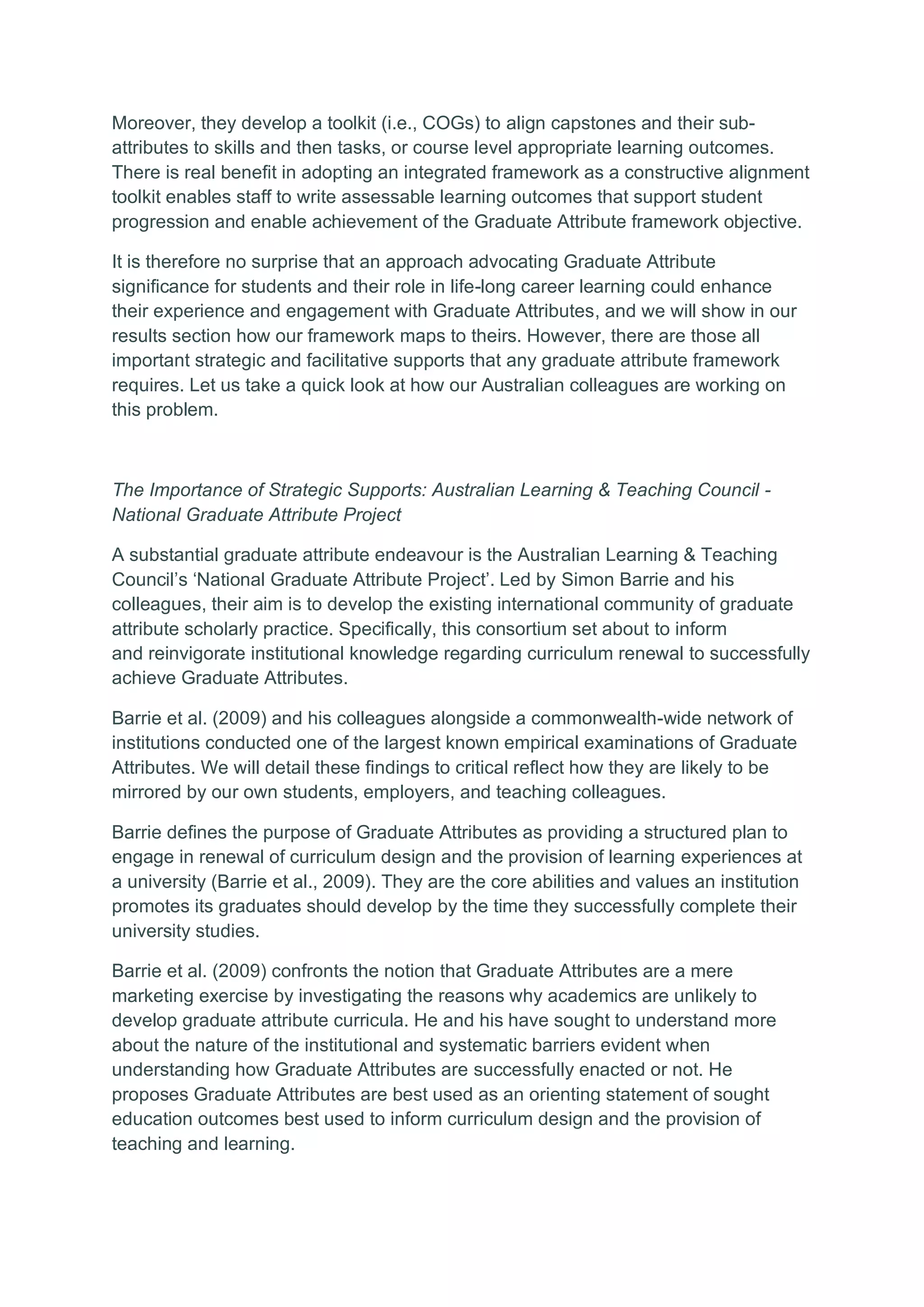
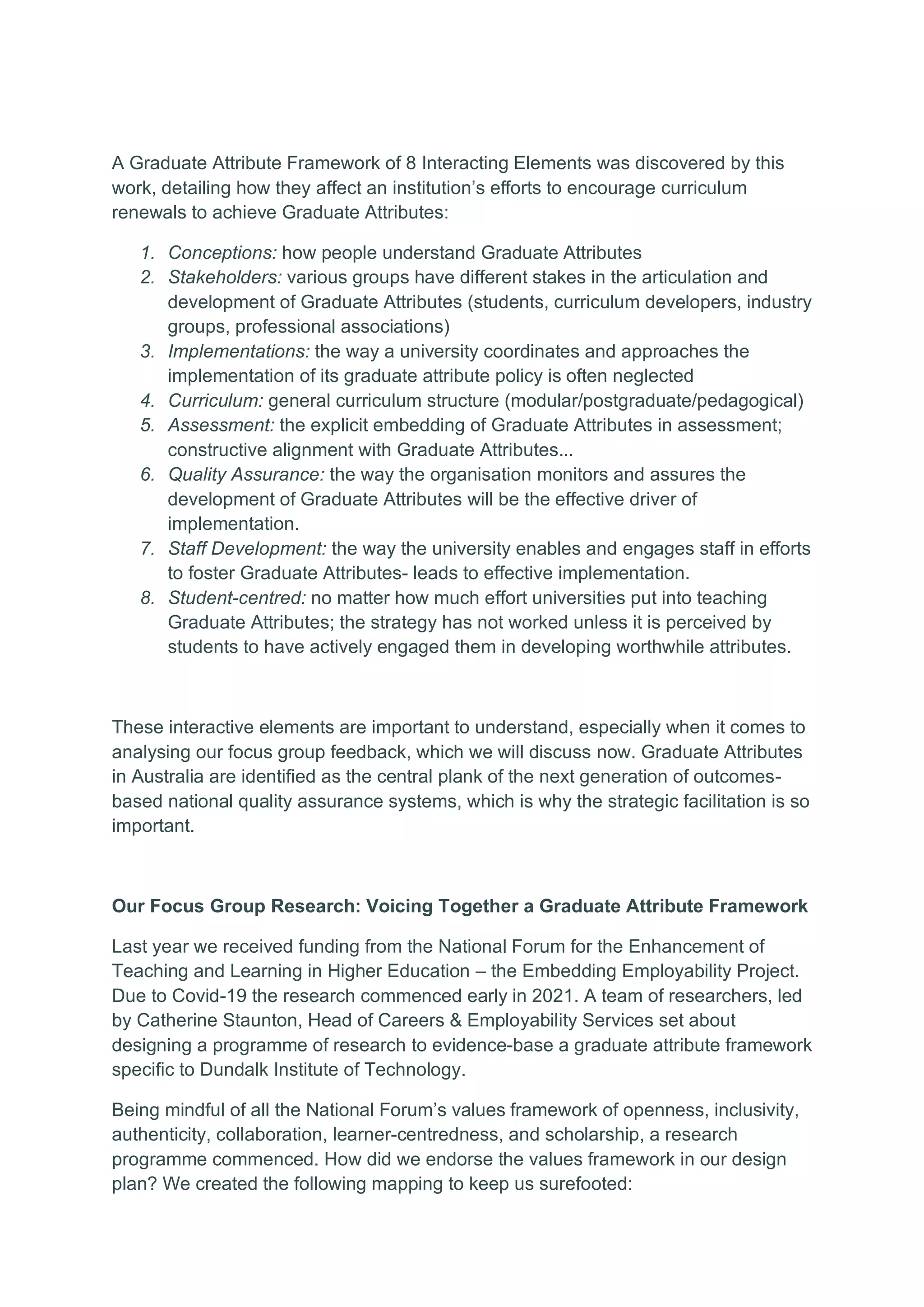
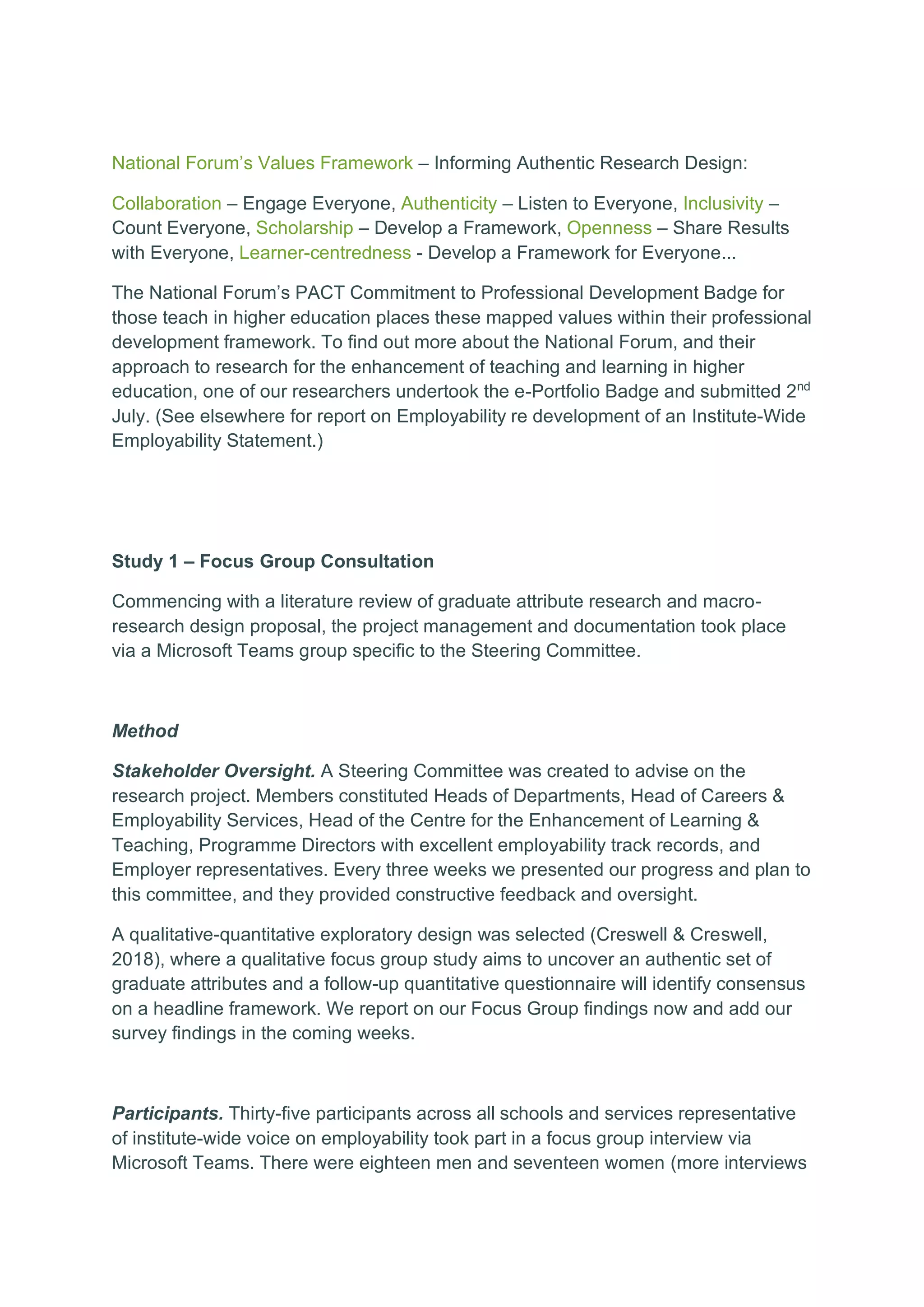
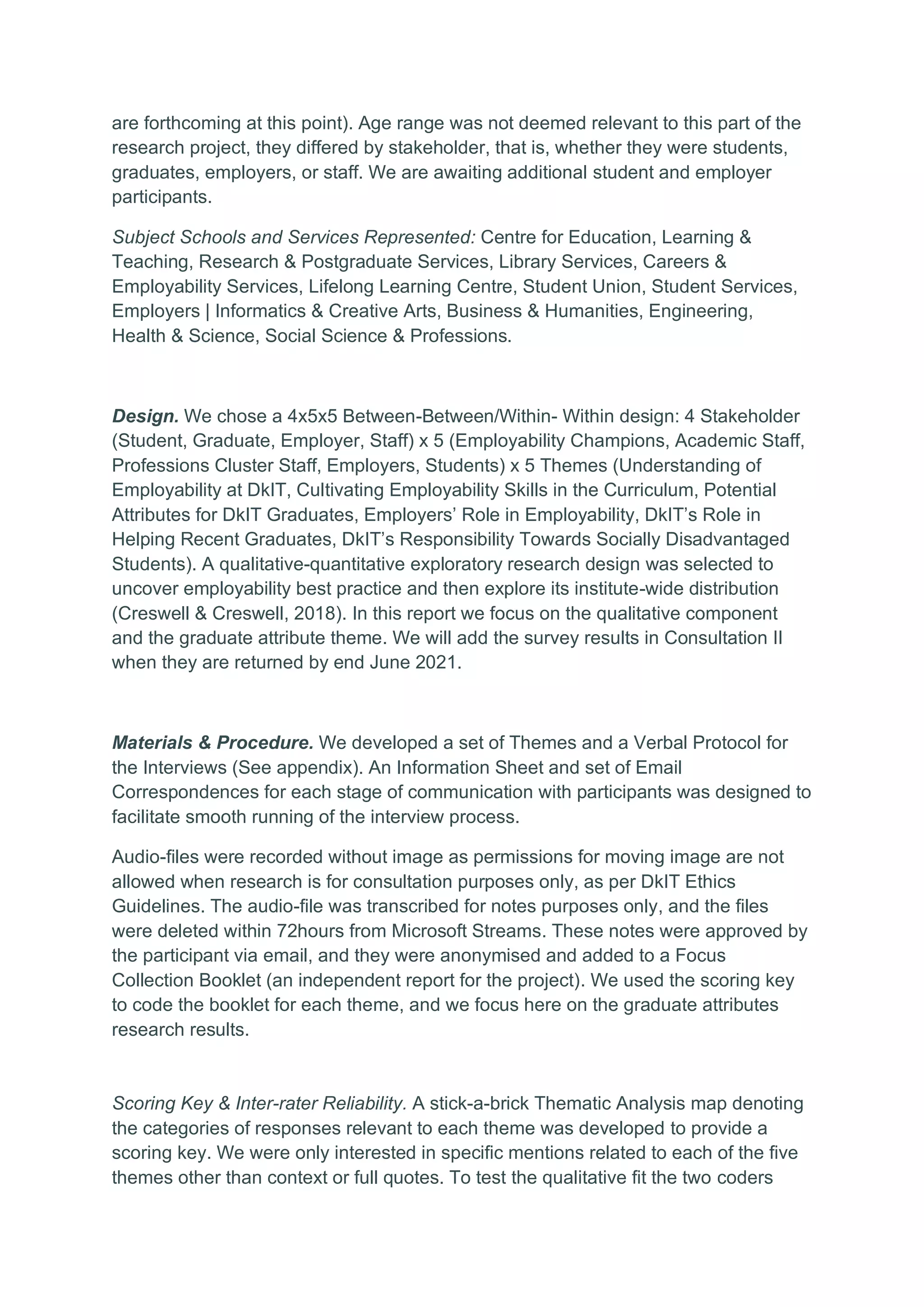
![independently used the key to score several protocols each. There was a
correspondence of 70-80% for mentions of interest. Adjustments were made to
further differentiate Embedded Employability [EE] into three distinct codes, namely –
Embedding Employability in the Curriculum [EEC], Employability Activities [EA], and
Employability Readiness [ER]. For the purposes of this report, we refer to [GA] as
Graduate Attribute and [GAD] as Graduate Attribute Development. Only these
information snippets (i.e., utterances) were used in the analysis.
Focus Group Coding of Segments
Scoring Key – Emerging Thematic Categories
___________________________________________________________________
Graduate Attribute [GA]
Graduate Attribute Development [GAD]
Curriculum Structure & Content [CSC]
Assessment Strategy & Assessment [CA, Exam, Placement]
Learning Outcomes [LO; Technical LO; Soft Skill LO]
[EE]
Embedded Employability in the Curriculum [EEC]
Employability Activities [EA]
Employability Readiness [ER]
Career Management [CM]
The Employer [Employer]
Employability Best Practice Examples [Best Practice]
Forward-Looking Employability Ideas [FL Employability]
DkIT-ness [DkIT-ness]
The Future of DkIT [Future DkIT]
Voiced Emerging Problems [VEP]
___________________________________________________________________
*The emerging best-fit themes * The emerging best-fit themes were mapped to qualitatively feedback
proportionately to Employability Statement [All], Employability Guide [All], Graduate Attributes
Framework, and Employer Forum. They are majorly thematic categories which sometimes may not be
mutually exclusive and may require more than one code to denote segmented bullet-point content
best (hence stick-a-brick adding process). It may be important to give some thought to the Voiced
Emerging Problems category elsewhere.](https://image.slidesharecdn.com/ssrn-id38783121-210702152158/75/Developing-a-Graduate-Attribute-Framework-in-Higher-Education-Focus-Group-Report-14-2048.jpg)
